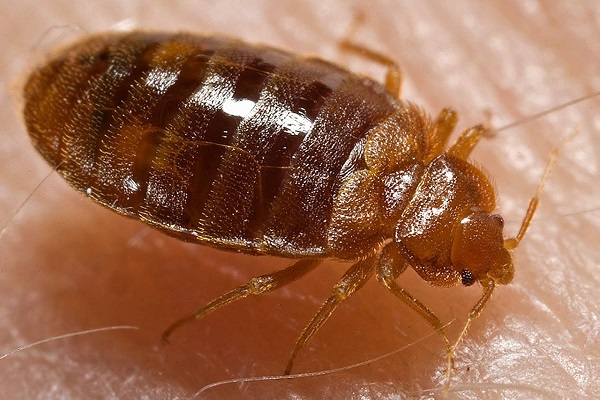The name “bedbug” comes from the fact that these insects typically hide in mattresses and feed at night while their human hosts are asleep. Bed bugs can’t survive or flourish without a steady supply of blood. Bedbugs have been following humans around for over 3,300 years, and they can be found just about anywhere people congregate, from private homes and hotels to workplaces and public transit.
Bedbugs may travel enormous distances thanks to their skill as hitchhikers. They hitch rides on bags, garments, and bed linens and can spread to other locations. Because of this, bedbug infestations can quickly spread. In addition, bedbug bites are not always obvious and might be mistaken for those of other pests, making infestations hard to detect and allowing populations to flourish unnoticed.
The most worrying aspect of bedbugs is their rapid reproduction rate. On average, females lay 1-5 eggs every day, with a maximum of 541. These nymphs can mature into adult bed bugs in around 21 days. Without early detection, a bedbug population can spread rapidly, infesting a whole home or structure. It can be quite challenging to eradicate an infestation once it has taken hold.
Identification of BedBugs
Because of their elusive nature, it is not unusual to have a serious infestation of bedbugs and never see a single bug. Bedbugs are difficult to detect until morning when you get bite symptoms you did not have the night before. Bite marks can appear in groups or patterns and can become red, itchy, and swollen. This is proof that bed bugs, and not some other kind of insect, are responsible for the bites. Droppings (dried blood flakes) can be found in the crevices and crannies surrounding your bed. In order to confirm an infestation, you should look in the following places:
- Behind light switches, pictures, and wall coverings.
- Put it in the corners of the room, under the bed, in the box spring, and behind the baseboards.
- In or beneath fissures or knots in wood or brickwork.
- The space hidden by a permanent headboard.
How do they get into our beds?
Bedbugs are a universal nuisance, showing up anywhere people congregate in large numbers. The density of a population has a far stronger correlation with infestations than does poor personal cleanliness. For example, hotels are more likely to have a bedbug infestation since numerous guests share the same room night after night. They may readily move from one location to another and are tough to spot. Keep an eye out for the telltale indicators of bedbugs when you’re riding public transportation or sitting in a public area. Always double-check a hotel’s bedding before settling in for the night. Check for bedbugs, bedbug eggs, and bedbug feces. Bed bugs are a serious problem, so if you find any in your accommodation, contact the hotel immediately. Check your luggage for bedbugs using a vacuum cleaner when you get back home. All of your clothes, even the ones you haven’t worn, should be washed in hot water. Be sure to check all used furniture for bedbugs before bringing it into your home. It’s important to keep in mind that bedbugs can squeeze through openings as small as a credit card. As long as there is human blood available, they can survive almost anyplace. A professional exterminator can inspect your furniture for bed bugs if you are unsure how to do so.
Bed bugs are ubiquitous and evidence of infestations stretch all the way back to 1500 BC. Although management was well-established by the mid-20th century, there has been a dramatic uptick in reports of bedbugs since the 1990s. More human mobility, more secondhand furniture exchange, increased emphasis on control of other pests, and improved pesticide resistance are all possibilities, but the specific cause of this increase is unknown.
It is crucial to keep your home clean and free of clutter to reduce the likelihood of bed bugs infesting your space. Bed bugs can get into your home through extremely small openings. Seal any holes or gaps with caulk or weatherstripping to keep the bed bugs out and be sure there are no bed bugs lurking in your possessions before bringing them inside. Be cautious to check all of your things for bed bugs before bringing them inside your home. Bags, couches, and everything else need to be inspected.
Infestations of bed bugs typically occur at night while you are fast asleep. In strongly infested locations, however, they are opportunistic feeders and will take a blood meal during the day if given the chance. The feeding period for bedbugs is typically between 5 and 10 minutes. When they’re full, they retreat to more isolated areas where they hide for extended periods.
Why use our services?
All of the professionals we send to your property are fully licensed and insured. We’ll get your house back in order so you can feel comfortable and safe again and we’ll show you how to keep it that way. We provide pest control services with a 100% satisfaction guarantee.
The dreaded bedbug. (2023, May 16). Around the Bugs. Information retrieved from: https://www.pestworld.org/pest-guide/bed-bugs/bed-bugs/
The 16th of May, 2023: bed bugs. In the “Free Encyclopedia,” Wikipedia. From Wikipedia, the free online encyclopedia

